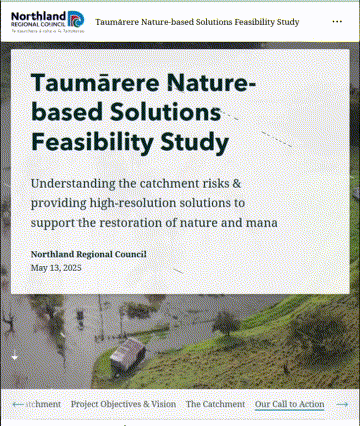Restoring the Taumārere: Nature-Based Solutions for Flood Resilience and Community Well-being.
Service Area: Environmental Engineering
Industry: Environmental Restoration / Flood Risk / Water Resources
Service: GIS Mapping & Analysis, NbS Assessment, On-farm Environmental Planning, Hydrology, Catchment-Scale Planning.
Location: Taumārere catchment, Far North, Northland
Deliverables:
Community engagement to ground the project in local issues
Hydrological assessment for climate resilience
Financial viability assessment, financial and monitoring frameworks developed
High-resolution relative environmental risk & NbS opportunity mapping
Catchment risk “hotspots” and restoration prioritisation maps
Case study site to test cost estimates, monitoring and funding, as well as hydraulic performance.
The Bottom Line
VISION’s partnership with Ngāti Hine and community groups is setting the foundation for a resilient Taumārere catchment. By combining high-resolution GIS analysis, hydrological expertise, and mātauranga Māori, this project maps out practical opportunities for flood mitigation, water quality improvement, and biodiversity restoration.
Task
To identify risks within the catchment and map possible locations for NbS deployment across the Taumārere catchment — reducing flood risk, restoring ecological health, and strengthening cultural connections.
Problem
The Taumārere catchment faces multiple, interconnected challenges:
Flooding that damages land and infrastructure.
Degraded water quality affecting rivers, kai (food gathering), and cultural values.
Loss of wetlands, riparian cover, and biodiversity.
Traditional engineered flood mitigation that often fails to deliver ecological and community benefits
Solution
VISION worked alongside Ngāti Hine and local groups to co-design a catchment-wide framework for implementing NbS. Key features included:
Three-Phased Approach: From community engagement and baseline data collection, to mapping risks and planning long-term financing.
Community Ownership: Ensuring solutions align with the aspirations of Ngāti Hine and local landowners.
Integrated Mapping: Using high-resolution terrain, hydrology, and land use data to identify priority zones for NbS such as wetlands, riparian planting, erosion control, and floodplain reconnection.
Financial Sustainability: Exploring funding streams, eco-tourism, and payment for ecosystem services to support long-term viability.
Benefits
Enhanced Ecological Health: Restored hydrology, improved water quality, and increased biodiversity.
Community Well-being: Strengthened cultural connections, mahinga kai opportunities, and recreation spaces.
Flood Resilience: Natural solutions that slow, store, and filter water while reducing damage from extreme rainfall.
Sustainable Future: A pathway for catchment healing and resilience for generations to come.
Why It Matters
This project isn’t just another report. It’s a working example of what’s possible when:
-
Local insight, science, and restoration are combined early.
-
We map risk and opportunity before spending money.
-
Solutions are selected for the unique needs of the catchment.
-
We prove that Nature-based Solutions can be planned, costed, monitored, and delivered strategically.
Dive Deeper: A Living Case Study
While the formal study provides the technical foundation, we believe in making our work accessible and transparent. Alongside the project, we developed an interactive StoryMap to share findings visually, engage the community, and bring the data to life for non-technical audiences.

Jonathan Cousins
Senior Hydrological Engineer,
MEng (Civil)
Go beyond the case study with our five-part technical series, written by the senior engineers who led the Taumārere project. We demystify Nature-based Solutions, starting with the project blueprint and a clear definition of what NbS means for Aotearoa.
Follow along as we show what these solutions look like on the ground, detail our innovative GIS mapping process for finding the right solution for the right place, and break down the real-world costs and funding pathways. This series is a practical blueprint for anyone looking to plan and deliver a successful catchment restoration project.
















